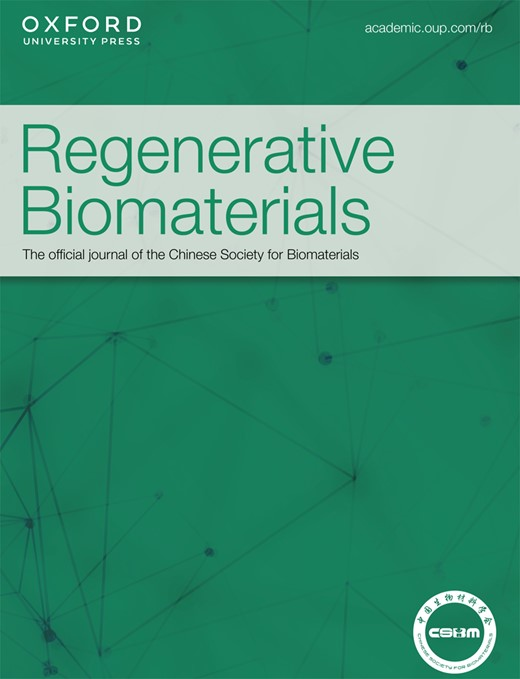生物功能性羟基磷灰石涂层三维多孔聚醚醚酮支架,用于增强骨科应用中的成骨和骨整合能力
IF 5.6
1区 医学
Q1 MATERIALS SCIENCE, BIOMATERIALS
引用次数: 0
摘要
聚醚酮酮(PEKK)是一种高性能热塑性特种工程材料,具有类似骨骼的机械性能,在生物医学领域受到广泛关注。三维(3D)打印技术能够生产出具有蜂窝状结构的多孔支架,其特点是精确控制孔径、孔隙率和相互连接性,在组织工程中具有巨大的应用潜力。多孔 PEKK 支架的理想孔隙结构尚未阐明。通过三维打印机制作了五种孔径的多孔 PEKK 支架:P200(225 ± 9.8 μm)、P400(411 ± 22.1 μm)、P600(596 ± 23.4 μm)、P800(786 ± 24.2 μm)和 P1000(993 ± 26.0 μm)。随后,根据体外实验结果,选择了力学性能和成骨作用的最佳孔径 P600。为了提高多孔 PEKK 支架的界面生物活性,在相传溶菌酶(PTL)涂层的诱导下,通过原位生物模拟矿化生成了羟基磷灰石(HAp)晶体。在此,我们开发了一种在 PEKK 支架上显示 HAp 晶体的微/纳米结构表面。体外和体内实验证实,多孔 PEKK-HAp 支架具有高度相互连接的孔隙和功能性表面结构,有利于生物相容性和骨诱导性,从而促进骨再生。因此,这项工作不仅证明了 P600 支架的孔隙结构适用于 PEKK 骨科植入物,还揭示了一种涉及三维打印和仿生矿化的协同方法,该方法有可能产生具有增强骨诱导性和成骨能力的定制化三维 PEKK-HAp 支架,为骨组织工程提供了一种前景广阔的策略。本文章由计算机程序翻译,如有差异,请以英文原文为准。
Bio-functional hydroxyapatite coated 3D porous polyetherketoneketone scaffold for enhanced osteogenesis and osteointegration in orthopedic applications
Polyetherketoneketone (PEKK), a high-performance thermoplastic special engineering material, maintains bone-like mechanical properties and has received considerable attention in the biomedical field. The three-dimensional (3D) printing technique enables the production of porous scaffolds with a honeycomb structure featuring precisely controlled pore size, porosity, and interconnectivity, which holds significant potential for applications in tissue engineering. The ideal pore architecture of porous PEKK scaffolds has yet to be elucidated. Porous PEKK scaffolds with five pore sizes P200 (225 ± 9.8 μm), P400 (411 ± 22.1 μm), P600 (596 ± 23.4 μm), P800 (786 ± 24.2 μm), and P1000 (993 ± 26.0 μm) were produced by a 3D printer. Subsequently, the optimum pore size, the P600, for mechanical properties and osteogenesis was selected based on in vitro experiments. To improve the interfacial bioactivity of porous PEKK scaffolds, hydroxyapatite (HAp) crystals were generated via in situ biomimetic mineralization induced by the phase transited lysozyme (PTL) coating. Herein, a micro/nanostructured surface showing HAp crystals on PEKK scaffold was developed. In vitro and in vivo experiments confirmed that the porous PEKK-HAp scaffolds exhibited highly interconnected pores and functional surface structures that were favorable for biocompatibility and osteoinductivity, which boosted bone regeneration. Therefore, this work not only demonstrates that the pore structure of the P600 scaffold is suitable for PEKK orthopedic implants but also sheds light on a synergistic approach involving 3D printing and biomimetic mineralization, which has the potential to yield customized 3D PEKK-HAp scaffolds with enhanced osteoinductivity and osteogenesis, offering a promising strategy for bone tissue engineering.
求助全文
通过发布文献求助,成功后即可免费获取论文全文。
去求助
来源期刊

Regenerative Biomaterials
Materials Science-Biomaterials
CiteScore
7.90
自引率
16.40%
发文量
92
审稿时长
10 weeks
期刊介绍:
Regenerative Biomaterials is an international, interdisciplinary, peer-reviewed journal publishing the latest advances in biomaterials and regenerative medicine. The journal provides a forum for the publication of original research papers, reviews, clinical case reports, and commentaries on the topics relevant to the development of advanced regenerative biomaterials concerning novel regenerative technologies and therapeutic approaches for the regeneration and repair of damaged tissues and organs. The interactions of biomaterials with cells and tissue, especially with stem cells, will be of particular focus.
 求助内容:
求助内容: 应助结果提醒方式:
应助结果提醒方式:


